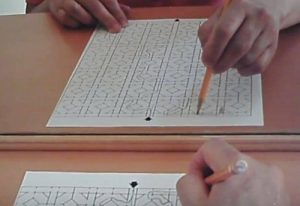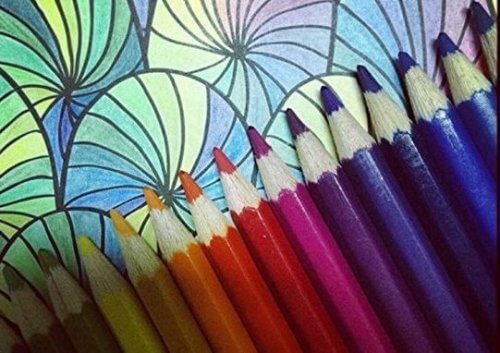The Guillour Method for Increasing Concentration in Children

There are children who complete tasks quickly without taking their eyes off of their work. However, there are also children who take more time, as any distraction will take their attention away from the task.
The Guillour Method is an interesting option for these individuals. The Guillour method for increasing concentration in children is based on observation with the use of a mirror.
The method involves structured exercises using lines and tracing. On some occasions, the child will be asked to draw in the same direction that he observes in a mirror. On other occasions, the child will have to draw in the opposite direction.
Some exercises involve having to find the way out of a maze without looking away from the mirror. Continue reading to learn more about this interesting and effective method.
What does the Guillour Method involve?
The structured exercises involving lines and tracing are carried out in front of a mirror. The participant copies or traces a drawing that he sees in the mirror, rather than looking at the drawing directly.
This requires the child to focus on symmetry and space relations. Furthermore, it forces the child to concentrate on minor details in the image. To complete the exercise, the child must reproduce the figure or series of figures in the mirror, look for hidden shapes and figures, or trace paths.

Benefits of the Guillour Method
- Helps the child by stimulating the hemispheres of the brain, as the child must use both simultaneously to complete the tasks.
- Produces an improved neural and cerebral connection.
- The tracing techniques improve the child’s hand eye coordination.
- Since the child observes the image in the mirror and then copies it onto paper, the method develops concentration cycles.
- The Guillour Method improves observation abilities.
- A child’s problem solving skills improve as a result of broader logical thought.
- Increases a child’s self-esteem.
- Calms anxiety.
- Improves the ability to pay attention.
- Improves school performance.
Attention and the functioning of the two hemispheres of the brain
When we manage to concentrate on something, our attention focuses on one explicit item. This process involves the working of both of the brain’s hemispheres.
The left hemisphere of the brain is responsible for logical, analytical and verbal functions. The right hemisphere controls non-verbal, spatial and analogical tasks.
The method’s exercises are structured and serve to raise concentration levels and promote the connection between both hemispheres. This contributes to lower anxiety levels.
Furthermore, psychomotor stimulation is also achieved by alternating arm functions in order to complete the exercises.
Other methods for improving concentration in children
There are other methods besides the Guillour Method that also help to improve children’s concentration:
- Tiles or fretwork: This refers to a game of counting squares and paying attention to minor detail. The participant may also be asked to reproduce a tile pattern, or copy its mirror image.
- Crossword puzzles, word searches, etc. These are excellent activities that help children concentrate and also develop patience.
- Jigsaw puzzles and finding differences. These games are fun both for children and adults. Jigsaw puzzles help children find solutions and exercise deductive reasoning. Searching for differences between two or more images helps children to focus on details.
- Dominos. A classic game with multiple benefits. Joining equivalent images develops a child’s strategic capacity.
- Memory. Just like the name of this popular childhood activity suggests, this game puts a child’s memory to work. And it improves concentration as well. There are a number of ways to use the cards. For example, the child can try to memorize the order or position of the cards before turning them face down. Or, children can begin with the cards face down and take turns flipping two over at a time to try to form pairs.
- Mazes. Searching for a way through or out of a maze may seem easy, but there often comes a point when things get difficult. This is a great way to practice patience. Mazes also help children put their deductive reasoning to the test.
- Painting mandalas. An ideal resource for restless and active children, mandalas require patience, concentration and effort. Using art to improve concentration is a wise move.
Who does the Guillour Method benefit
This method is especially useful with children with ADD or ADHD (Attention Deficit Disorder or Attention Deficit Hyperactivity Disorder). It is also a great tool to use with patients who have suffered brain injury.
However, the method is totally effective on people who need to increase concentration in general. The exercises can be used by children and adults alike.
The Guillor Method exercises should be carried out slowly. In other words, the child should first take some time to contemplate the image in the mirror. Then, the child should carry out the assigned task carefully and thoughtfully.
When the child goes over the lines with his finger or pencil, he focuses better on what he is doing.
“It’s always a good idea to start using this method as soon as you detect your child has difficulty learning. The sooner you begin to stimulate your child, the sooner you will see results.”
Recommended exercise
The most well-known Guillour Method exercise consists of placing a transparency over a worksheet on a table, in front of a mirror. Rather than looking at the worksheet, the child looks at his reflection in the mirror.
The participant uses different colored pencils to trace the outlines of the figures on the worksheet. Using the left index finger, the child goes over the divisions, paying attention to the images.
With the right hand, he circles and underlines the images that are the same. Left-handed children do the opposite, tracing the forms with the right hand, and circling or underlining with the left.
All cited sources were thoroughly reviewed by our team to ensure their quality, reliability, currency, and validity. The bibliography of this article was considered reliable and of academic or scientific accuracy.
- Método Guillour staff. (n.d.). El Método Guillour para aumentar la concentración en los niños. https://www.metodoguillour.com/sala-de-prensa/el-metodo-guillour-para-aumentar-la-concentracion-en-los-ninos/
This text is provided for informational purposes only and does not replace consultation with a professional. If in doubt, consult your specialist.
